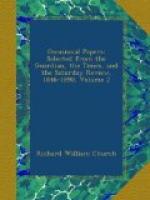If this “vast system” is a crux to any one, we cannot think that even Dr. Newman’s explanation will make it easier. He himself recoils, as any Englishman of sense and common feeling must, at the wild extravagances into which this devotion has run. But he accepts and defends, on the most precarious grounds, the whole system of thought out of which they have sprung by no very violent process of growth. He cannot, of course, stop short of accepting the definition of the Immaculate Conception as an article of faith, and, though he emphatically condemns, with a warmth and energy of which no one can doubt the sincerity, a number of revolting consequences drawn from the theology of which that dogma is the expression, he is obliged to defend everything up to that. For a professed disciple of the Fathers this is not easy. If anything is certain, it is that the place which the Blessed Virgin occupies in the Roman Catholic system—popular or authoritative, if it is possible fairly to urge such a distinction in a system which boasts of all-embracing authority—is something perfectly different from anything known in the first four centuries. In all the voluminous writings on theology which remain from them we may look in vain for any traces of that feeling which finds words in the common hymn, “Ave, marls Stella” and which makes her fill so large a space in the teaching and devotion of the Roman Church. Dr. Newman attempts to meet this difficulty by a distinction. The doctrine, he says, was there, the same then as now; it is only the feelings, behaviour, and usages, the practical consequences naturally springing from the doctrine, which have varied or grown:—
I fully grant that the devotion towards the Blessed Virgin has increased among Catholics with the progress of centuries. I do not allow that the doctrine concerning her has undergone a growth, for I believe it has been in substance one and the same from the beginning.
There is, doubtless, such a distinction, though whether available for Dr. Newman’s purpose is another matter. But when we recollect that modern “doctrine,” besides defining the Immaculate Conception, places her next in glory to the Throne of God, and makes her the Queen of Heaven, and the all-prevailing intercessor with her Son, the assertion as to “doctrine” is a bold one. It rests, as it seems to us, simply on Dr. Newman identifying his own inferences from the language of the ancient writers whom he quotes with the language itself. They say a certain thing—that Mary is the “second Eve.” Dr. Newman, with all the theology and all the controversies of eighteen centuries in his mind, deduces from this statement a number of refined consequences as to her sinlessness, and greatness, and reward, which seem




